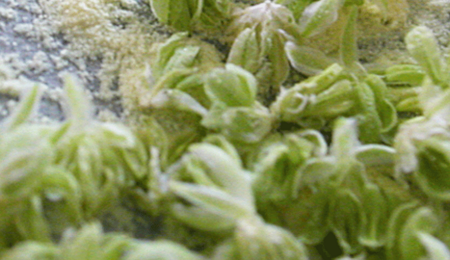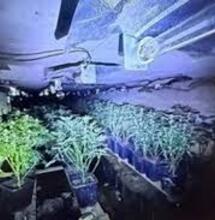Water hash 101

Water hash is another favorite method of making concentrates employed all over the world. Its name comes from the water process used to collect glands from the trim, leaf, and buds. On a fundamental level, the process works because cannabinoids are not water soluble, meaning that the desired resins are not damaged by contact with water and ice.
Water hash can be smoked as loose, granular resin or pressed into traditional hashish: High-quality loose hash can easily be pressed into hashish using nothing more than the palm of one hand and some light, brisk friction, applied using the thumb of the other hand. Loose or pressed, many people are still enthralled by the unique, full-spectrum experience of this potent natural product. Water hash can be made in small or large quantities, and turnkey extracting systems can be purchased to simplify the process. It is also possible to make water hash using home-gathered equipment, but with inexpensive kits available, the savings are often negligible. Pre-made systems offer increased precision and efficiency for the water hash process, and their availability contributed to a surge in water hash’s popularity during the late 1990s and early 2000s. Water hash’s two decade run of dominance ended with the rise of solvent-extracted hash; shatter, wax, and other butane hash-oils have muscled aside bubble hash on many dispensary shelves in the United States over the last few years. But this competition from solvent hash has also inspired water hash makers to step their game up, inspiring an increased emphasis on appearance and flavor. Ultra-fine water hash is now being sold as “solventless wax,” reflecting the broad demand for solvent-free products that mirror the desirable consistency and refined flavor profile of solvent-extracted hash. High-grade water hash is also great for edibles, and any experienced dabber will tell you that “five star” hash is very dabbable. It’s also next to impossible to seriously injure yourself or anyone else making water hash, because the process doesn’t involve any flammable chemicals or potentially explosive machinery.
HOW WATER HASH WORKS
All water hash methods use water, ice, and agitation to separate resin glands from plant material. Water and plant material are placed in a bucket that has been lined with filtration bags, similar in composition to the screens used for making dry sift kief. Like those screens, the bags filter the glands by micron size, separating the hash from the trash. A micron is one-millionth of a meter, or .001 millimeters. The material is stirred to knock the trichomes free, and while the plant material floats in the top bag, the glands (which are heavier) sink and are collected in the lower bags. Ready-made systems use multiple bags that sort the glands by size: Unlike kief making, the material is separated in one step rather than through repeated sieving. Usually the material is processed once, but some commercial hash makers process it a second time to further isolate the THC. As with all extraction methods, cold temperature is a key element of water hash production. The ice keeps the water and material very cold so the glands remain brittle and snap off with agitation. After the material is agitated in ice water, it’s allowed to settle. Then the bags are separated, and the glands are removed from each one. After the water hash is dried, it’s ready to smoke. Water hash varies in color and can be many shades of white, brown, red, even purple. When extracted from the finest-grade material, the potency of water hash can test as high as many solvent hash products, with up to 80% cannabinoid content.
A NOTE ON YIELDS
Processing 227 grams of high-quality material usually yields between 18 grams (5% yield) to 35 grams (15% yield). Yields increase with the quality of the starting material. However, in some instances, such as with Tangie, obtaining a yield over 7% using water is nearly impossible. This is one reason solvent-based methods and other, newer extraction techniques have overtaken water processing in popularity. But there are considerations other than yield; the full-spectrum effects and natural flavor profile of water hash are unique because the process preserves the terpenes in the glands. For this reason, some people prefer high-quality water hash to solvent-extracted products.
WATER HASH BASICS
All gland-bearing plant material (leaf, trim, buds, shake, or any combination of the four) can be used to make water hash. Dried or frozen material can also be used. When making water hash it is important to keep the material and the environment very cold. Heat is the enemy. Low-temperature water, near freezing, makes trichomes brittle enough to snap off. A cool room keeps terpenes from vaping off. Humidity is also a factor. Avoid humid storage conditions to prevent deterioration from bacteria or molds. One method is to store wet or dried cannabis in the freezer. When using material that has not been stored in this way, place it in the freezer until it gets cold. It’s crucial to treat the cannabis delicately to preserve all of the glands and keep them on the vegetation. Take the utmost care when bucking buds from twigs and stems. Don’t mangle the material from excessive trimming or grinding. Coarsely chopped cannabis is most convenient. Remove twigs, stems, and twist ties, because they can tear the hash-making bags. Whether using a ready-made bag system or materials from your kitchen, the basic principles of making water hash are the same. There are slight contributions by technique, patience, and proficiency, but what primarily determines the quality of the hash you produce is the caliber of the plant material and the quality and size of the filter.
READY-MADE BAGS
For water hash, the ready-made bag systems are an excellent choice. They can be used many times. Bubble Bags are the design of Fresh Headies in Canada. Bubbleman, the head hash master of Fresh Headies, has traveled extensively, spreading the good word of water hash. He can also be found moderating in online forums on this topic. Bubble Bags are available in one-gallon, five-gallon, and twenty-gallon sizes. All filtration systems are available in sets of four or eight bags and as singles. There are several other brands of bags. The eight-bag system separates hash into finer categories. The size difference between just-ripe THC glands and overly mature or premature ones allows them to be separated into grades.
USING BUBBLE BAGS
First, the coarse filter bag is secured in a bucket and the water, ice, and plant material are added. The cannabis is agitated using a kitchen mixer or a drill with a paint-mixing attachment — it’s worth noting that hash “purists” deplore this level of agitation. After the material settles, the starter bag is pulled out and squeezed. The bulk of the plant material now held in this bag is set aside. This material can be processed again, but the resulting product will be lower grade, though still suitable for cooking. Line the empty bucket with the additional bags. The finest bag goes in first, so it will be on the bottom. The green water is poured into the bucket, lined with the filtering bags. Pull the bags out one by one and collect the material in the bottom of each one. Allow the end product to dry. Toss the water out or use it for watering plants.
HOME-MADE BAGS
It is possible to make your own bags or to make a smaller amount of water hash without using bags at all. To make bags, acquire silk screen in the appropriate mesh size. Standard silk-screen material is available in several size increments between the desired 100 to 150 strands per inch. The screen must be attached to a tightly woven, water-resistant material (nylon works well) so that the silk screen forms the bottom of the bag. Multiple bags can be made with different screening levels in the 50- to 150-micron range for separating the water hash by quality. The finest screen produces the purest hash. Multiple bags should be designed to fit inside one another, with the finest mesh bag being the largest, and the coarsest mesh bag being the smallest. A separate bag made for coarse filtering (200–250-micron-sized gaps) is used to separate the bulk of the vegetation from the glands in the first phase. This bag should line the bucket. It does not get layered with the other bags, so it should be as large as the bucket allows.
VARIATIONS ON A THEME: OTHER DIY METHODS OF WATER HASH PRODUCTION
Any overview of the water hash-making process would be incomplete without mentioning the many alternate variations on water hash—all of which use slightly different methods to combine water and agitation. Many of these methods sprung from the DIY ingenuity of home hash makers. These methods include the jar shaker method, the coffee filter method, the bucket method, and the blender method.
THE JAR SHAKER METHOD
The simplest method for making water hash is using a homemade shaker. This method is the easiest in terms of time and equipment, but it also produces the least amount of hash, and the product won’t be as pure as with methods using micron-gauged filtering bags. Manual agitation is more labor intensive, but it requires no electricity and can be accomplished anywhere that the materials can be gathered.
EQUIPMENT
• Up to an ounce of brittle, dry trim, bud bits, or shake • Water • Ice • Sealable glass jar • Colander or wire-mesh strainer • Slotted spoon or tea strainer • Coffee cone (#4) • Paper coffee filters • Dish towel • Paper towels • Scraping tool (spoon, credit card, or business card)
METHOD
Grind the marijuana to a coarse powder, similar to dried cooking herbs such as oregano or basil, using a bud grinder, coffee grinder or blender for a very short time. Place the material in the jar, up to 1 quarter full. Pint, quart, and 2 quart jars all work. Add equal amounts of ice and very cold water until the jar is almost full. Leave about an inch of space at the top of the jar, then seal it and shake for 10 minutes. Pour the water/material mix into a bowl and put it in the refrigerator to allow it to settle for an hour. Most of the ice may melt in this time. Remove the floating plant material with a tea strainer or slotted spoon. The plant material can be saved and reprocessed. Manual shaking does not remove all trichomes on the first round. Once the plant material has been removed, allow the silt to resettle at the bottom of the bowl for 15–20 minutes. Drain off one-half to two-thirds of the water slowly, with an eye to saving all of the silt-like water hash material in the bottom of the jar. Set up the cone lined with a paper coffee filter. Pour the contents of the bowl through the cone slowly. As the water hash collects in the bottom of the filter, the water will drain more slowly. Allow all of the water to drain from the filter. Then remove the filter from the cone, allowing it to flatten with the wet hash inside. Set it on a dish towel and carefully remove as much water as possible by pressing with the towel or paper towels. Split the coffee filter along the seam and open it like a butterfly spreads its wings. Collect the material inside using a spoon or card to scrape it loose from the paper. The material is easier to separate from the coffee filter when it’s dry or slightly damp. The material can dry either before or after it’s removed from the filter. Even if some of the material is collected for use before the drying completes, the water hash should be allowed to air dry over a day or two to reduce the chance of mold. After the water hash is dry, it can be used, stored, or pressed into hash.
THE COFFEE FILTER METHOD
The coffee filter method works well for small-scale water hash production and uses common kitchen equipment. Chop the plant material to a coarsely ground consistency. Cone-type coffee makers look like a pointier version of a standard coffee maker basket. They are inexpensive and are available at kitchenware stores, some gourmet coffee shops, grocery stores, or on the web. The #4 size or larger is recommended. Both reusable and disposable filters for these cones are available at the same shops where the cone was purchased. This method yields nice hash, but not like the product of the precise micron-sized filters of bubble bags. Also, there is no final filtration of small vegetative matter, so the product is not as pure as the hash made in a bag system. Still, water hash produced using this method is equal in quality to dry-screened kief.
EQUIPMENT
• Ice • Cold water • Dried plant material (coarsely ground) • Blender • Mixing bowl • Colander or wire-mesh strainer • Cone-type single-cup coffee maker • Reusable metal cone coffee filter, or silk screen • Coffee filters • 2–3 large glass jars with tight-sealing lids • Dish towel • Paper towels • Scraping tool (spoon, credit card, or business card)
THE BUCKET METHOD
The essentials of water hash methods are the same, whether using a ready-made system or working from your own homemade bags.
EQUIPMENT
• Ice • Cold water • Hydrogen peroxide • 2 buckets with at least one lid • Dried bud/trim/leaf material • Handheld mixer or drill with paint-mixing attachment • Bag system • Long rubber gloves • Large towel • Roll of paper towels • Spoon or plastic card
METHOD
First, clean and sterilize the buckets and equipment. Mix 10 ounces (1¼ cups) of 3% hydrogen peroxide per quart of water to make a rinse. If you’re using a bag in the first round, place this bag in the bucket. Add equal amounts of ice and water until the bucket is two-thirds full. Add the prepared plant material. Wearing the long rubber gloves, use your hands to submerse it evenly in the ice water. Up to 3½ ounces (100 grams) of plant material can be used in a 5 gallon bucket. One convenient tool for agitating the mix is a kitchen mixer. Another choice for agitating the water is a drill with paint mixer attachment. A larger mixing tool, powered by an industrial drill is used for the 20 gallon bags. Punch hole(s) in the bucket lid to accommodate the mixing attachments. This keeps the material from sloshing out while it’s being agitated and allows the mixer to run hands-free. Agitate the material for 15 minutes and then allow the mixture to settle. If using a ready-made system, the speed recommended in the instructions should be used. As a general rule of thumb, lower speeds work well when mixing amounts under 5 gallons. Medium to high speeds are better when using a system that is 5 gallons or larger. As it is mixed, the material becomes frothy. You may want to remove the suds before recommencing. Blend the material up to 4 times for 15 minutes at a time. Mixing the material more times produces higher yields, but also results in more particulate vegetative matter. Longer times produce less pure results, especially if multiple bags aren’t separating the hash into grades. With a single collection mechanism, a shorter time should be used on the first round. After this hash is collected, the plant material can be reprocessed using a longer mixing time. Multiple bags allow the material to be processed all at once without sacrificing a high-grade collection. After the mixing round is completed, let the mixture sit for at least 30 minutes to give the glands time to sink into the collection filters. If most of the ice has melted add more. In cold weather the bucket can be set outside to keep the mixture cold. Once the material has settled, it’s time to separate the glands. If the agitation has been done inside a bag, pull out this bag, removing the bulk of the plant material. The bucket now contains green water with silt in the bottom. This silt is the water hash and a small amount of particulate vegetative matter. Line the second bucket with the collection bags. The finest mesh bag goes on the bottom, so it’s added to the bucket first. The coarsest bag is the last bag added, so it’s the top layer. The first bag has separated out everything over the 200–250-micron size, depending on its mesh size. Now the successive layers of the bags will do the grading for you. Pour the water into the bucket that is lined with the filter bags. Slowly lift out each bag, allowing time for the water to drain. Be patient. If the entire bottom of the bag seems to be clogged it may be necessary to reach in and gently push some material to the side. Stir up the material as little as possible. After each bag is removed, lay it on the towel and pat off excess water. Wrap it with towels and squeeze it to remove more water. The inside of each bag contains some tan to brown silt-like material. Carefully arrange the bag so that the material is accessible. Blot the material off with a paper towel. Remove it from the bag using a credit card or a spoon. If multiple bags were used, keep the grades separated. Place the material in a flat-bottomed bowl, or on a plate or other surface where it can be left to dry, then put it in a cool, dark place where it will get some airflow but won’t blow away once dry. The material will appear dry in about 12 hours, but allow a full week to completely dry and cure. Allow the moisture to evaporate from the remaining material by keeping it open to air in a cool space to prevent mold growth.
THE BLENDER METHOD
Place enough plant material in the blender to fill it halfway. Add ice and cold water in equal amounts until the blender is full. Turn the blender on at full speed for 45 seconds to a minute. Let the mixture settle. Repeat 3 or 4 times. The more times the blender runs, the higher the yield. Pour the mixture from the blender through a colander or strainer into a mixing bowl. Bowls designed to pour, such as a pancake batter bowl or a 1–2 quart measuring cup, work best. This step separates out the bulk of the plant material. Pour the water through the reusable coffee filter into the glass jars until they are about two-thirds full. Sealable glass canning jars work well. Smaller vegetative matter will collect in the coffee filter. However, the glands are small and pass through the reusable coffee filter into the glass jars. After pouring the water/trichome mix through the filter, pour two more cups of water through the filter so remaining trichomes pass through it. Seal the jars. Place them in the refrigerator for an hour. The glands settle and form silt at the bottoms. Tapping the jars lightly a few times on a tabletop helps settle some of the floating material. Remove the jars from the refrigerator without stirring up the material that has collected at the bottom. Pour off the top two-thirds of the water. The goal is to retain the glands that are gathered in the bottom while removing as much water content as possible. Set up the cone on top of a suitable container such as a quart jar. Drain the remaining water and silt through the coffee filter with a disposable filter paper. The flow of water through the filter slows as the material collects; allow it to drain completely. Carefully remove the paper coffee filter from the cone. Flatten it with the material inside by patting it with a towel. Material can be dried before or after it’s collected from the coffee filter. Drying it inside the coffee filter takes a little longer but the hash is protected from blowing away and is easier to remove from the paper when both are dry. To dry in the coffee filter place it atop a layer of paper or cloth towels. Once it’s dry, split the filter along a seam. Collect the material using a spoon or plastic card. Allow the material to fully dry before pressing or storing, which takes a day or two depending on the environmental conditions and the amount being dried.
TIPS
Use a siphon rather than a pour to remove one-half to two-thirds of the water from the container. This gives you more control and creates less turbulence so the silt at the container bottom is not disturbed. Use clean, flexible aquarium tubing. Place the other end of the tubing into a sink or other drainage area. Heat speeds up the drying process. Use a propagation mat, usually used to sprout seedlings—it will maintain a 74°F (23°C) temperature—or a heating pad set on low. Place the mat under a towel and put the drying water hash on top. Food dehydrators set on low are another effective controlled heat source.
WATER HASH DO’S AND DON’TS
Fresh-frozen material works best. If it was not stored in the freezer, place it inside until it’s frozen. Use a standard two-beater mixer, a drill with a paint-mixing attachment, or blender. Don’t get impatient in the final steps! Dry the material thoroughly at the end of the process. Water hash stored before it is dried molds, ruining it. Water and mash left over at the end of the process contain nutrients present in the plant material. It’s great for watering plants, using as mulch, or adding to compost.



